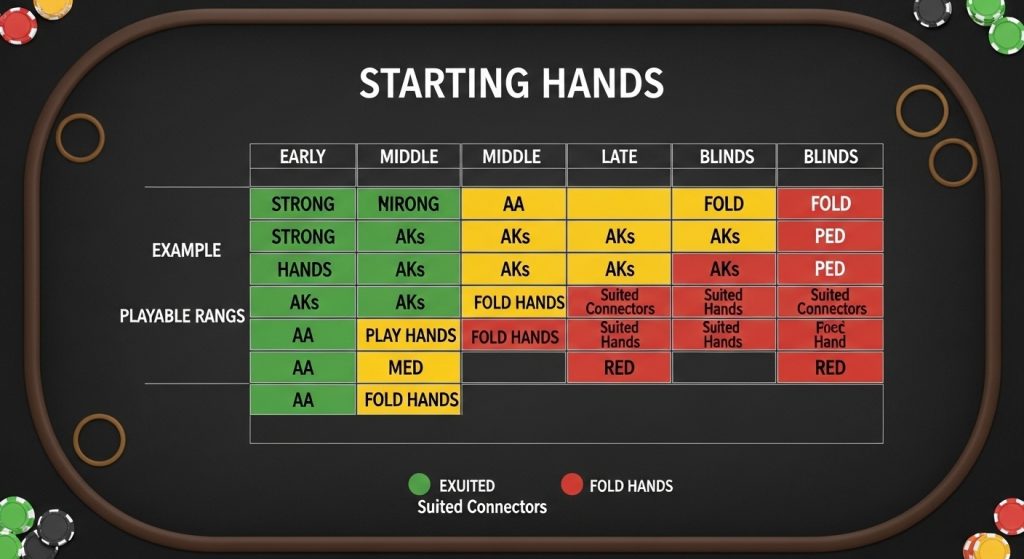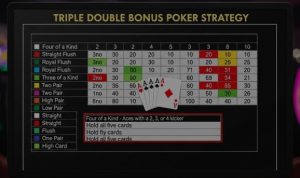When it comes to improving your poker game, few tools are as essential as a Poker Starting Hands Chart. Whether you’re playing Texas Hold’em online, at a local casino, or in a friendly home game, understanding which hands to play — and from which positions — can dramatically improve your results.
In this guide, we’ll dive deep into what a poker starting hands chart is, how to use it, and why it’s the foundation of a solid poker strategy. Let’s explore how mastering starting hands can transform you from a casual player into a serious contender at the tables.
What is a Poker Starting Hands Chart?
A Poker Starting Hands Chart is a visual or tabular guide that outlines which two-card combinations (known as “starting hands”) you should play in various positions at the table.
Since Texas Hold’em involves 169 unique starting hands (after accounting for suits), not all hands are created equal. Some hands, like A♠A♥ (Pocket Aces), are strong favorites to win, while others, like 7♦2♣ (Seven-Deuce Offsuit), are among the weakest possible combinations.
A good starting hands chart helps you make quick, informed decisions before the flop — saving you chips, improving your win rate, and keeping you disciplined.
Why a Starting Hands Chart Matters
Many beginners make the mistake of playing too many hands. While poker is a game of skill and psychology, discipline starts with hand selection. The starting hands chart is your first line of defense against poor decision-making.
Here’s why it’s important:
- Mathematical Advantage: Strong starting hands have higher expected value (EV) — meaning they win more often in the long run.
- Position Awareness: Your seat at the table determines how aggressively you can play. Good charts take position into account.
- Consistency: Using a chart helps you develop a structured, repeatable approach instead of relying on emotions.
- Reduced Mistakes: It minimizes playing marginal hands out of position — one of the biggest leaks in poker.
Breaking Down Poker Positions
Before using any poker starting hands chart effectively, you need to understand table position. The chart usually divides hands based on these key positions:
- Early Position (EP): Seats immediately after the blinds. You act first post-flop — so you need stronger hands.
- Middle Position (MP): You get more information before acting. You can open up slightly.
- Late Position (LP): Includes the cutoff and button. You have the most information — allowing looser play.
- Blinds (SB/BB): You’ve already invested chips, but you act early post-flop. These require a different approach.
Position is everything in poker. The later your position, the more hands you can profitably play.
Example: Basic Poker Starting Hands Chart (Texas Hold’em)
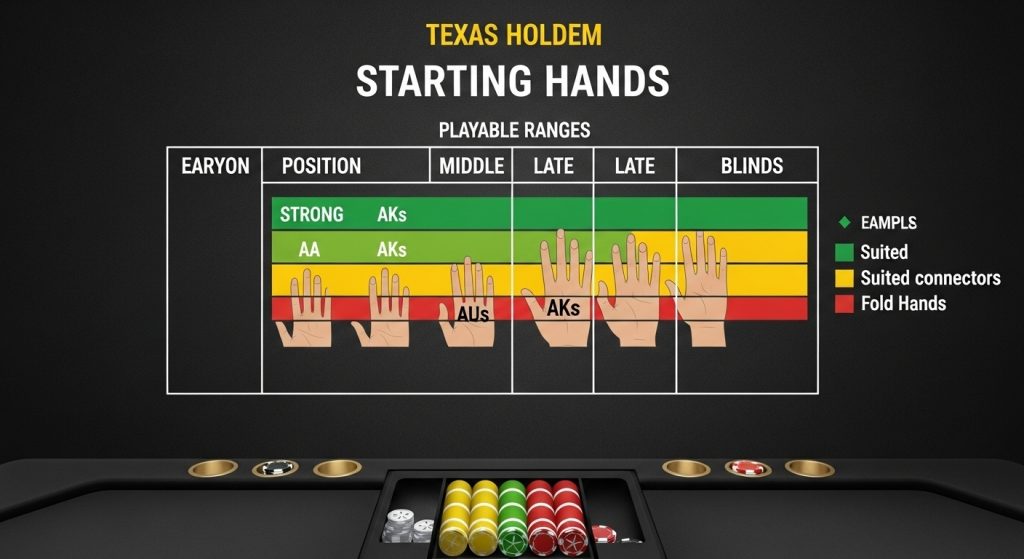
Here’s a simplified example of a starting hands chart for No-Limit Texas Hold’em:
| Position | Strong Hands (Raise) | Playable Hands (Call/Raise) | Fold |
| Early | AA, KK, QQ, JJ, AKs | TT, AQs, AKo | Everything else |
| Middle | AA–TT, AKs–ATs, AKo, KQs | 99–88, AJs, KQo | Weak offsuit aces, low connectors |
| Late (Cutoff/Button) | AA–77, AK–A9, KQ–KJ, QJ–JT | Suited connectors (98s–65s), small pairs | Weak offsuit hands |
| Blinds | Strong pairs, broadways, suited aces | Mix of calls vs. steals | Trash hands |
Note: “s” stands for suited (same suit), “o” stands for offsuit (different suits).
This chart serves as a baseline. Advanced players often adjust their ranges based on table dynamics, stack sizes, and opponents’ tendencies.
Suited vs. Offsuit Hands
You’ve probably noticed poker charts emphasize suited hands. That’s because suited cards (like A♥K♥) can make flushes, adding about 2.5% more winning equity compared to offsuit equivalents (A♠K♦).
However, being suited doesn’t make a weak hand strong — it simply adds marginal value. For example, 7♥6♥ is playable in late position but not under the gun (UTG).
Pocket Pairs: The Foundation of Strength
Pocket pairs are among the easiest starting hands to play:
- High Pairs (AA–TT): Always raise or re-raise preflop.
- Medium Pairs (99–66): Raise in middle to late position; call small raises.
- Low Pairs (55–22): Best played in multiway pots when you can “set mine” (try to hit a third card).
Pocket pairs have strong “implied odds” because if you hit a set, you can often win a big pot.
Broadway Hands and Suited Connectors
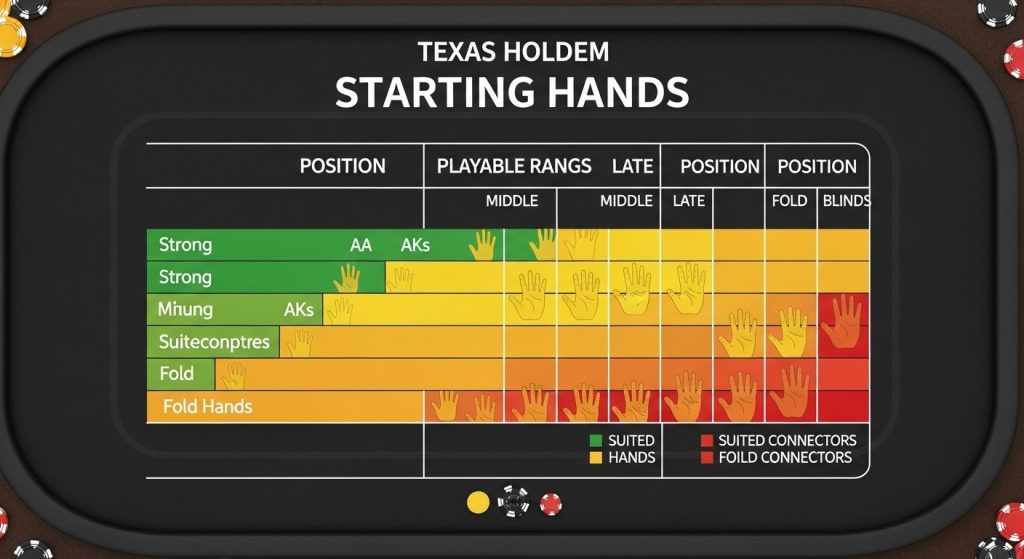
Broadway hands (AK, AQ, KQ, QJ, JT) are powerful because they can make the top straight and often dominate weaker hands. Suited broadways add flush potential.
Suited connectors (like 9♠8♠, 7♥6♥) are speculative hands — they rely on hitting straights or flushes. Play them cautiously and mostly in late position where you can control pot size.
Adapting Your Chart for Table Type
Different poker formats require slightly different starting ranges:
1. Cash Games
- Deep stacks allow for more speculative play.
- You can play suited connectors and small pairs profitably.
- Focus on post-flop skill and position.
2. Tournaments
- Stack sizes fluctuate constantly.
- Early stages favor tight play; late stages reward aggression.
- Use push/fold charts when short-stacked.
3. Online Poker
- Faster pace and aggressive opponents.
- Broaden your range slightly and mix in occasional bluffs.
- Use HUD stats to identify tight or loose players.
Common Mistakes Players Make
Even with a chart, players often fall into traps. Avoid these errors:
- Ignoring Position – Playing A♣9♦ from early position can get you into tough spots.
- Overvaluing Suited Cards – Not all suited hands are worth playing; 5♠2♠ is still weak.
- Failing to Adjust – Good players adapt to changing table conditions.
- Playing Emotionally – Stick to your chart; don’t chase losses or tilt.
How to Use a Poker Starting Hands Chart Effectively
- Memorize Core Ranges – Start with tight, strong hands and gradually expand.
- Practice Discipline – Fold marginal hands, especially out of position.
- Review Your Sessions – Track which hands you played and how profitable they were.
- Update Regularly – As your skill improves, tweak your chart to suit your playing style.
A poker chart isn’t a rigid rulebook — it’s a foundation for smart decision-making.
Advanced Adjustments: Beyond the Chart
Once you master basic charts, start making nuanced adjustments:
- Tight tables: Loosen up your range; steal more blinds.
- Loose tables: Tighten up and wait for premium hands.
- Aggressive opponents: Trap with strong hands; avoid marginal spots.
- Passive tables: Play more speculative hands with strong implied odds.
Your goal is to use the chart as a guide, not a crutch. The best players adapt based on real-time dynamics.
Printable Poker Starting Hands Chart
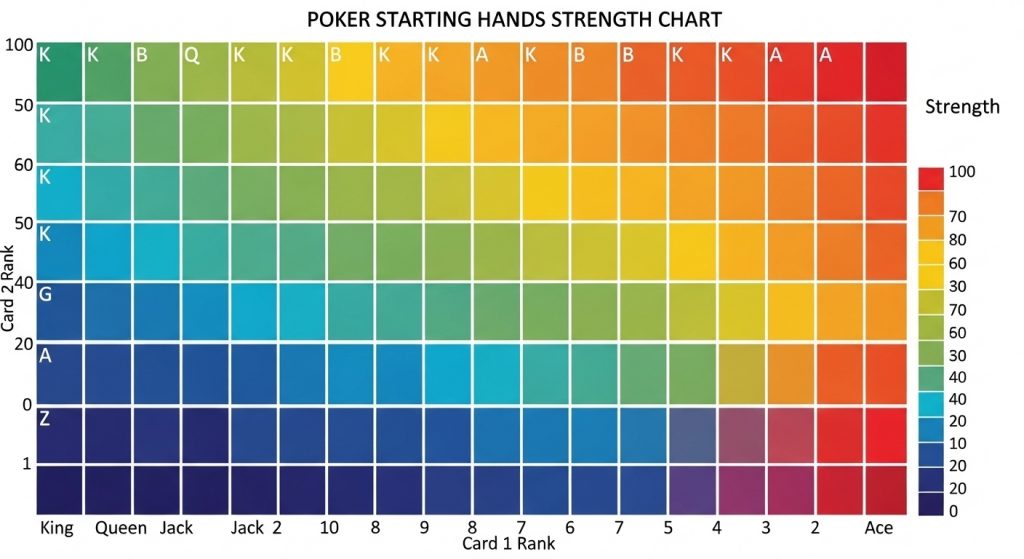
Many players keep a printable or digital chart nearby for quick reference. You can find versions that show:
- Color-coded grids for easy reading.
- Position-based charts (UTG, MP, CO, BTN, SB, BB).
- Charts for both cash games and tournaments.
If you’re new to poker, download a free chart and study it before every session. Over time, the ranges will become second nature.
Final Thoughts
A Poker Starting Hands Chart is more than just a beginner’s tool — it’s the roadmap to consistent, profitable poker. By learning which hands to play and from where, you build the foundation for long-term success.
Discipline, patience, and position awareness are the keys to mastering poker. As you gain experience, you’ll learn to adjust your ranges, exploit opponents, and develop your unique strategy — but it all starts with the basics. So, print that chart, keep it by your side, and start building a winning habit today.

